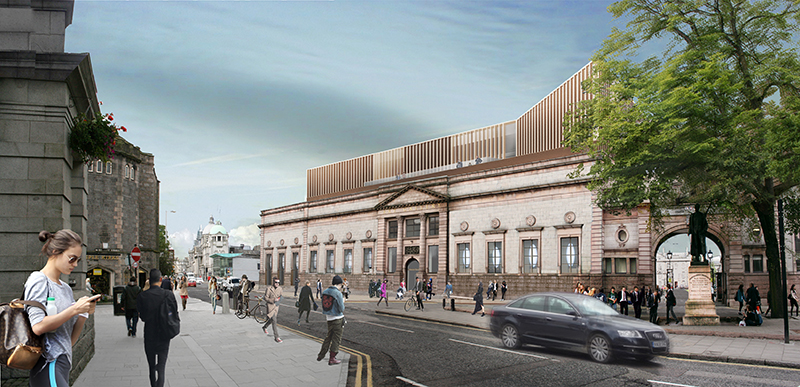
John Rennie from NBT discusses the use of woodfibre insulation from the Pavatex range to enable thermal performance improvements to Aberdeen Art Gallery
A grade II listed building with impressive neo-classical façades, Aberdeen Art Gallery is one of the most popular tourist attractions in the north east of Scotland, welcoming more than a quarter of a million visitors each year. The Gallery, which includes the Cowdray Hall and the Remembrance Hall, has undergone a £30 million transformation to enhance the facilities, with improvements to the public realm, a rooftop extension and new exhibition areas.
Critical to the success of the project was the need to improve the thermal performance of the original Victorian building to enhance visitor comfort and drive energy efficiency and reduced operational costs. As the gallery is of solid stone construction with listed façades, this had to be achieved in a way that would neither compromise the building physics nor alter the external aesthetics of the structure. Hoskins Architects specified Pavadry and Pavaflex woodfibre insulation from the Pavatex range to address these challenges.
MOISTURE CONTROL
The traditional appearance and listed status of the gallery building meant that installation of an external skin of insulation was not possible, so the only option was internal wall insulation IWI.
Avoiding changes to the appearance of the building was just one of the considerations for the specification, however. Equally critical was the need to protect the structure from potentially damaging changes to the building physics that could result in trapped moisture, damp and rot. Use of a conventional insulation board could trap moisture at the vulnerable interface between the insulated internal wall build up and the external wall. The specification therefore needed to achieve the required thermal performance improvements while ensuring that any moisture entering the building fabric – from either the internal environment or the driving rain, in the wet and exposed Aberdeen climate – could be absorbed and released gradually by the internal wall build up.
COMPLETE INSULATION SYSTEM
The original lathe and plaster walls were removed and the gallery walls were stripped back to the original granite surface. This was coated with a lime levelling plaster.
The Pavadry woodfibre insulation was then prepared for installation with a lime adhesive bonding coat applied to the reverse side.This was to ensure that the Pavadry layer securely adhered to the granite substrate. The Pavadry was also mechanically fixed to the internal surface of the external walls, creating a robust and permanent solution.
A Pavatex woodfibre insulation board specifically designed as a retrofit solution for internal insulation of stone and solid brick buildings, Pavadry will contribute to the insulated wall build up at Aberdeen Art Gallery and will ensure the building is not compromised despite altering the building physics through improvements to the building’s thermal performance.
Leveraging the natural properties of woodfibre and the integral vapour control layer embedded in the Pavadry board, this layer provides active moisture control through absorption and redistribution of moisture, regulating moisture at safe levels and slowly releasing it to prevent issues with mould or dry rot.
To enhance the thermal performance of the wall build up, a 50mm layer of Pavaflex was then installed. A flexible woodfibre insulation material with outstanding thermal performance and slump resistance, Pavaflex was not suitable for installation at the vulnerable external wall interface but will work in tandem with the Pavadry layer to achieve the combination of thermal improvements and moisture management required.
With the insulation layer completed, a timber stud frame was erected and the DB3.5 airtight vapour barrier from the Pavatex range was stapled to the timbers and sealed with Pavatape. An integral element in the thermal performance delivered by the insulation, this element of the system will prevent heat loss through air leakage while allowing gradual vapour diffusion to help prevent moisture retention in the wall build up.
The internal walls were then reinstated with a cementitious plasterboard and a mineral plaster finish.
A NEW TWIST ON TRADITION
While it is important to bring heritage buildings up to standard with modern-day comfort and thermal performance standards, this must be achieved in the context of the building physics of traditional construction methods. The Aberdeen Art Gallery project highlights how contemporary insulation systems that harness the properties of traditional materials can solve these challenges.








